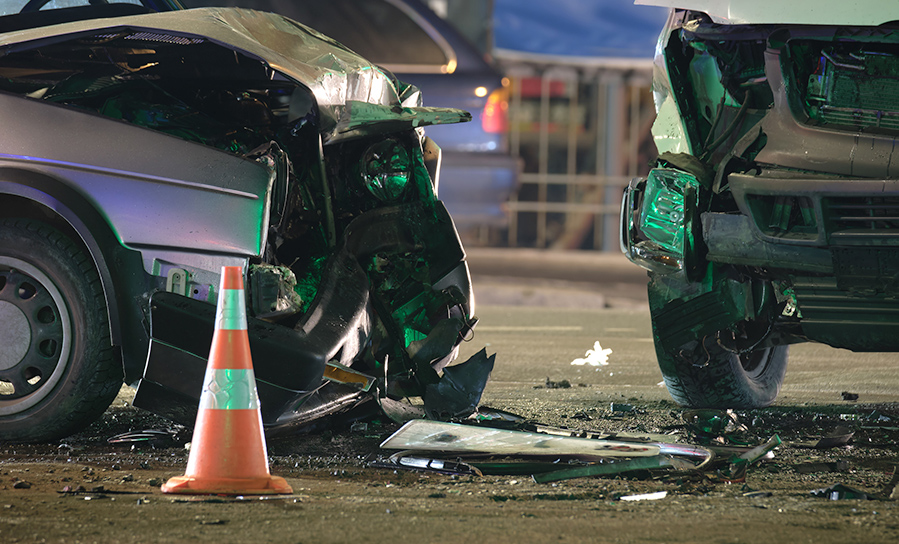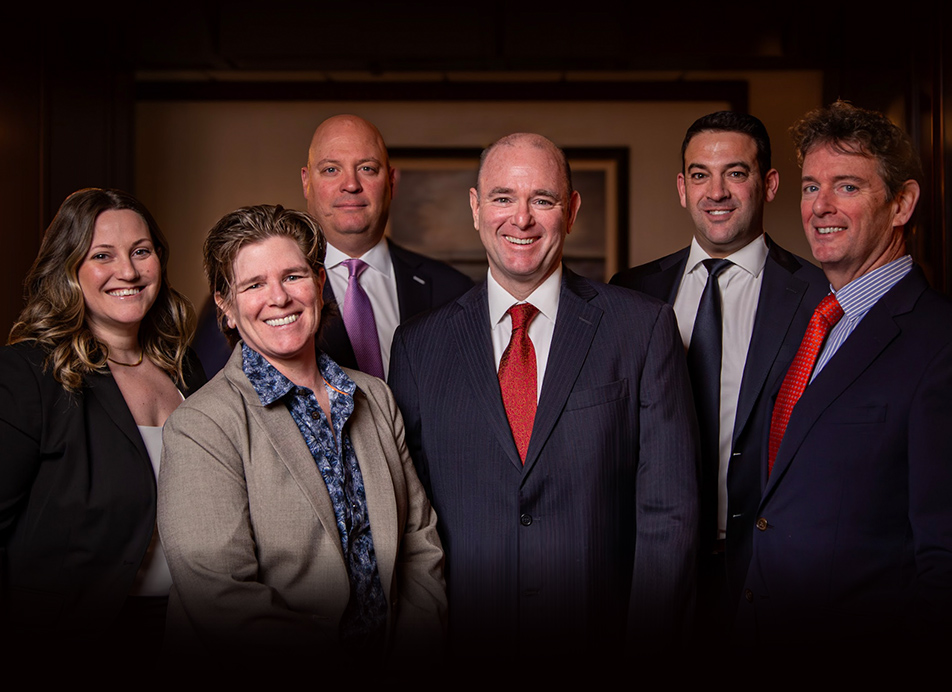Table of Contents
- 1 Let our skilled injury lawyers help.
- 2 Common Causes of Rear-End Accidents
- 3 Initial Steps to Take After a Rear-End Accident
- 4 Gathering Evidence and Documentation
- 5 Dealing with Insurance Companies
- 6 Importance of Hiring a Rear-End Accident Lawyer
- 7 Do I Need to Hire a Lawyer for a Minor Rear-End Accident?
- 8 Tips for Choosing the Right Rear-End Accident Attorney
- 9 How Long Do I Have to File a Claim After a Rear-End Accident?
- 10 Conclusion
Have you been involved in a rear-end car accident? Such accidents can be traumatic for those who experience them. They can result not only in substantial damage to the vehicle but also in injuries. It may get to the point where you need legal help to be compensated for any damages and cover expenses for medical treatment, lost wages, and other financial-related costs resulting from an accident.
This guide will discuss the common causes of rear-end accidents and what to do if one occurs. Following the outlined steps is essential to solidify your case should you pursue legal action and go through the insurance claim process. Let’s get started right now.
Common Causes of Rear-End Accidents
Rear-end accidents are among the most common car collisions, often resulting in significant injuries and damages. Understanding the typical causes of these accidents will help you prevent and handle claims effectively. Here are the most frequent causes:
Distracted Driving: This is considered one of the leading causes of rear-end collisions. It happens when drivers divert their attention from the road to activities such as texting, talking on the phone, eating, or adjusting the radio. These distractions reduce their reaction time and make stopping challenging to avoid hitting the vehicle in front, resulting in a rear-end crash.
Tailgating: Following too closely, or tailgating, is another major cause of rear-end accidents. Drivers who do not maintain a safe distance from the vehicle ahead have less time to react to sudden stops or slowdowns. This aggressive driving behavior increases the risk of collisions. If you are tailgating, you could be at fault for the accident.
Speeding: Excessive speeds reduce a driver’s reaction time to the vehicle in front. When a driver is speeding, it is much harder to stop quickly and safely, making rear-end collisions more likely. Speeding increases the risk of accidents and the severity of injuries and damages. Death could also result.
Sudden Stops: Accidents can occur when the leading vehicle suddenly stops. This could happen in heavy traffic, at pedestrian crossings, or due to unexpected obstacles in the road. The driver behind may not anticipate the stop, leading to a collision.
Weather Conditions: Rain, snow, fog, and ice are adverse weather conditions that can make roads slippery and reduce visibility. These factors can cause vehicles to skid or require longer stopping distances. Drivers who do not adjust their speed and follow distance accordingly are at higher risk of rear-end accidents. Planning ahead for road travel, especially on days with adverse weather forecasts, is crucial.
Inexperienced Drivers: Newer, inexperienced drivers may need more skills or confidence to react promptly to changing traffic conditions. They could misjudge distances, stop abruptly, or fail to notice slowing traffic ahead, contributing to rear-end collisions.
Mechanical Failures: Mechanical issues like brake failure or tire blowouts can also lead to rear-end accidents. It is crucial to maintain your vehicle so that all parts function correctly and prevent accidents caused by mechanical failure. Regular inspections by a licensed mechanic can ensure your car is in working order.
Drunk or Impaired Driving: Drivers who are under the influence of alcohol or drugs have impaired judgment and slower reaction times. This significantly increases the likelihood of rear-end collisions, as impaired drivers may not be able to stop in time or maintain a safe following distance. It should also be noted that those who drive impaired may violate New York State’s DUI laws. Criminal penalties apply if the vehicle operator is convicted.
Understanding these common causes can help you take preventative measures to avoid rear-end accidents. However, if an accident does occur, knowing the cause is crucial in establishing liability and seeking compensation. This information is also vital for a rear-end car accident attorney should you proceed with legal action.
Initial Steps to Take After a Rear-End Accident
Being involved in a rear-end accident, as we’ve mentioned, is stressful and overwhelming. Taking the proper steps immediately following the accident will protect your rights and ensure you receive the compensation you deserve. Here’s a look at the initial steps you need to follow after a rear-end accident:
Check for Injuries: First and foremost, check yourself and others for injuries. If anyone is injured, dial 911 and call for emergency services immediately. Even if injuries seem minor, seek medical attention, as some injuries may not be immediately apparent.
Move to a Safe Location: If it is safe, move your vehicle to the side of the road to avoid blocking traffic or causing further accidents. Turn on your hazard lights to alert other drivers to the accident scene.
Call the Police: Contact law enforcement to report the accident. Even if it’s minor, a police report will serve as an official record of the incident, which can be critical when you file an insurance claim or seek legal action later on.
Exchange Information: Exchange contact and insurance information with the other drivers involved. Ensure you get their name, address, phone number, insurance company, policy number, and vehicle information such as the make, model, and license plate number.
Document the Scene: Document the accident scene with photos or videos. Include damage to the vehicles, skid marks, road conditions, and any relevant signage or traffic signals. This documentation will be valuable evidence for determining liability and pursuing compensation.
Gather Witness Information: If there are witnesses to the accident, obtain their names and contact information. Witness statements can provide additional support for your version of events and help establish liability.
Avoid Admitting Fault: Avoid admitting fault or making statements that could be interpreted as an admission of liability. Even if you believe you may have contributed to the accident, leave the fault determination to the proper authorities and insurance companies. Answer questions in the presence of a qualified rear-end accident attorney.
Seek Medical Attention: Even if you don’t feel injured immediately after the accident, seek medical attention immediately. Some injuries, like whiplash, may not manifest symptoms until hours or days after the accident. Keep records of all medical treatment and expenses related to the accident when taking legal action or filing an insurance claim.
Notify Your Insurance Company: Report the accident to your insurance company immediately. Please provide them with accurate and detailed information about the accident. Avoid speculation or making assumptions about the fault.
Consult with an Attorney: Consult an experienced rear-end accident attorney to discuss your legal rights and options. An attorney can help you navigate the claims process, negotiate with insurance companies, and pursue suitable compensation for your damages and injuries. Duffy and Duffy have worked with car accident victims who have faced serious injuries. We will ensure you do not tackle the legal situation alone with our experienced lawyers who are familiar with the process.
Gathering Evidence and Documentation
Building a solid case after a rear-end accident relies heavily on gathering enough evidence and documentation to support your claim. The more evidence you collect, the better your chances of proving liability and recovering fair compensation. Here are the steps to gather the necessary evidence:
Document the Accident Scene: Take photographs of the accident scene from multiple angles, including the vehicles involved, damage sustained, skid marks, traffic signals, and road conditions. Note any weather conditions, visibility issues, or road hazards that may have contributed to the accident.
Record Vehicle Information: Record the make, model, year, and license plate number of all vehicles involved in the accident. Note any visible damage to the cars and the location of the damage, such as the front, rear, or side.
Obtain Witness Information: Obtain contact information from any witnesses to the accident. Ask witnesses to provide written or recorded statements detailing what they saw or heard leading up to the collision.
Get a Copy of the Police Report: Obtain a copy of the police report filed at the accident scene. The police report will contain valuable information, including the officer’s assessment of fault and statements from all parties and witnesses.
Keep Thorough Medical Records: Record all medical treatments for injuries sustained in the accident. Ensure the documents cover symptoms, diagnosis, medications prescribed, and follow-up appointments related to your injuries.
Track Financial Documentation: Keep track of all expenses related to the accident. These include medical bills, vehicle repairs, rental car costs, and lost wages. Retain receipts, invoices, and other documents that provide evidence of your financial losses.
Save All Communications with Insurance Companies: Save all communications with the insurance company, including emails, letters, and phone call transcripts. Keep a log of conversations, noting the date, time, and content discussed.
Obtain Expert Opinions: Obtain expert opinions from accident reconstructionists or medical professionals to support your case. Expert testimony can provide valuable insights into the cause of the accident and the extent of your injuries.
Consult with an Attorney: Consult with an attorney to ensure that you have a legal case for your rear-end car accident. An attorney will advise you on the types of evidence you need to support your claim and ensure that you meet all legal requirements.
Dealing with Insurance Companies
Navigating the insurance claim process after a rear-end accident can be complex. Insurance companies often prioritize their bottom line and may try to minimize or deny your claim. Understanding your rights and effectively dealing with the insurance companies is crucial to receiving fair compensation. Having an experienced rear-end car accident attorney negotiate on your behalf is also essential.
Report the accident as soon as possible and be careful with your statements. Review your policy to understand coverage limits, deductibles, and applicable exclusions. Knowing your policy will help you navigate the claims process more effectively. Provide accurate information when filing your claim. False or misleading information could result in denying your claim and possible legal consequences.
If the insurance companies try to settle the claim quickly, they may offer the lowest amount possible. Please do not accept the first settlement offer without carefully reviewing it. Your attorney may advise you to consider a counteroffer. They will negotiate for fair compensation to ensure you are covered for any expenses incurred due to the accident.
Finally, it is essential to keep thorough records of all expenses related to the accident, including medical bills, vehicle repairs, rental car costs, and lost wages. Such records will help support your claim and ensure you receive the compensation you deserve.
Importance of Hiring a Rear-End Accident Lawyer
After being involved in a rear-end car accident, you may wonder if it is necessary to hire a lawyer. While you are not legally required to do so, hiring an experienced attorney can significantly improve your case. Here are some reasons why hiring a lawyer could be beneficial for you:
Legal Expertise: A rear-end accident lawyer will deeply understand personal injury laws in New York. They can navigate the complexities of the legal system on your behalf, ensuring that your rights are protected throughout the process.
Investigation and Evidence Gathering: A lawyer will have the expertise and resources to conduct a thorough investigation into the circumstances of the accident. They can gather evidence such as witness statements, accident reports, and medical records. This will help strengthen your case and establish liability.
Negotiation Skills: Insurance companies often try to settle claims for as little as possible. Your rear-end accident lawyer will ensure that this does not happen. They are excellent negotiators who will advocate for your best interests during the process. They will accurately assess the value of your claim and negotiate for fair compensation for your injuries and damages.
Representation in Court: If a fair settlement cannot be reached through negotiation, a rear-end accident lawyer can represent you. They will prepare your case for trial, present evidence, and argue on your behalf to seek maximum compensation.
Do I Need to Hire a Lawyer for a Minor Rear-End Accident?
Hiring a lawyer can be a crucial decision. The real question is when you should hire one. Consider the following before making a decision:
Injuries: Injuries can occur even in minor rear-end accidents. Whiplash, soft tissue injuries, and concussions are common in such collisions. Symptoms may not manifest immediately, and you or your passengers may require medical attention or face long-term consequences. If the severity of injuries arises, consulting with a lawyer is advisable.
Complexity of the Case: Some rear-end accidents may seem straightforward, but others can be more complex, involving disputes over liability or multiple parties. A lawyer can help navigate these complexities and protect your rights.
Insurance Issues: Dealing with insurance companies can be challenging. They may try to minimize or deny your claim. Having a lawyer on your side can ensure that you receive a fair settlement and that your interests are represented.
Tips for Choosing the Right Rear-End Accident Attorney
Securing a rear-end accident attorney is crucial to your case. Here are some tips to help you choose the right one:
Experience: Find an attorney who specializes in personal injury law and has extensive experience handling rear-end accident cases. An attorney with a proven track record of success is more likely to understand your case and advocate effectively for you.
Reputation: Research the attorneys’ reputations among past clients and within the legal community. Reading online reviews, testimonials from past clients, and other sources can provide valuable insights.
Communication: Choose an attorney who communicates clearly and openly. They should answer your questions and address any concerns throughout the process.
Fee Structure: Car accident attorneys operate on a contingency fee basis, meaning you only pay if you successfully secure compensation.
How Long Do I Have to File a Claim After a Rear-End Accident?
After a rear-end accident, it is essential to remember that there is a statute of limitations for filing a personal injury claim. The statute of limitations in New York is three years from the accident date. This means you have up to this time to file a lawsuit in court.
It is essential to consult with an attorney as soon as possible to ensure you have a viable legal case related to your accident. Nonetheless, it could be a race against the clock once an accident happens.
Conclusion
A rear-end car accident can result in significant damage and serious injuries. If you believe you need legal representation to help secure the compensation you deserve, Duffy and Duffy can help. Their Uniondale, New York office serves individuals in New York City and Long Island who have experience dealing with car accidents and personal injuries. For more information on how they can help, please call 516-394-4200.











